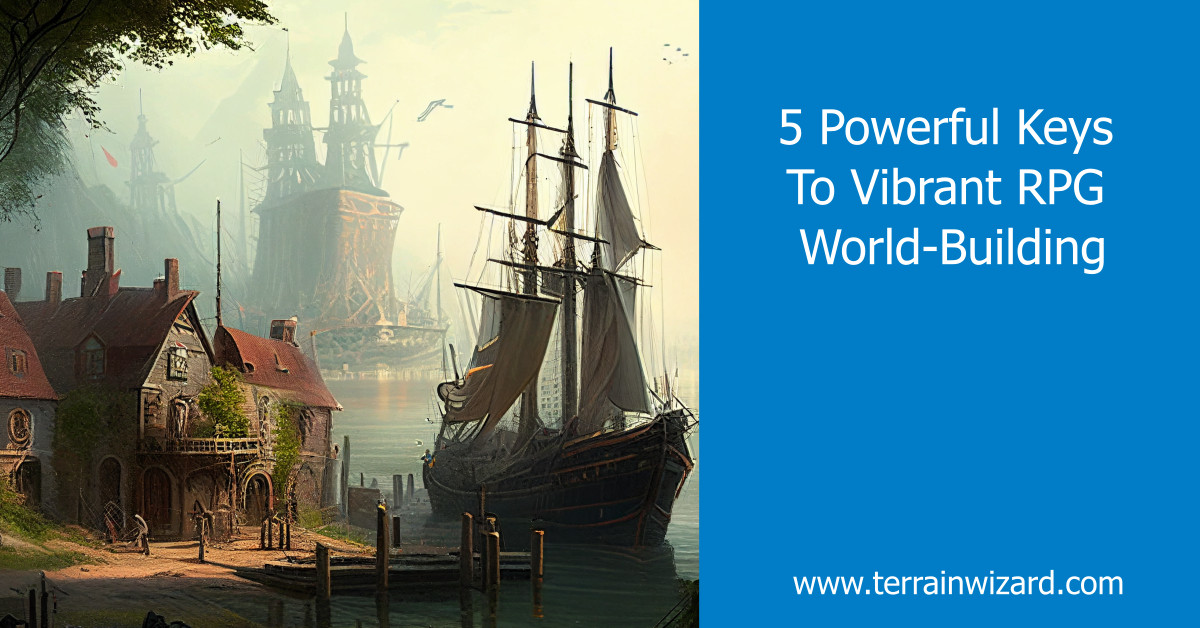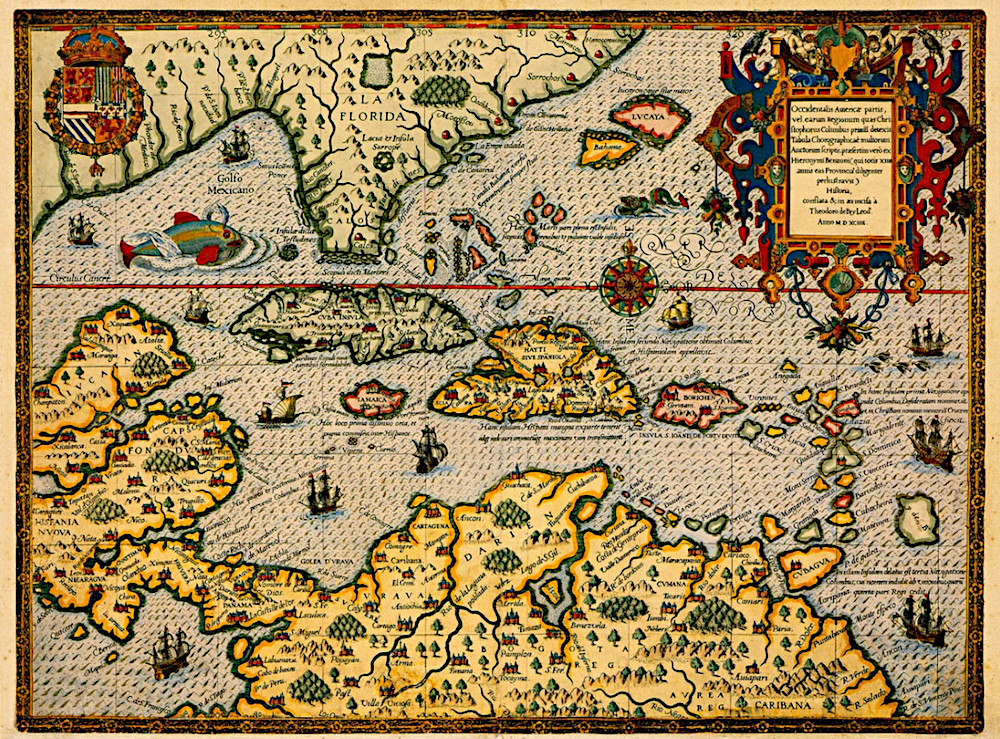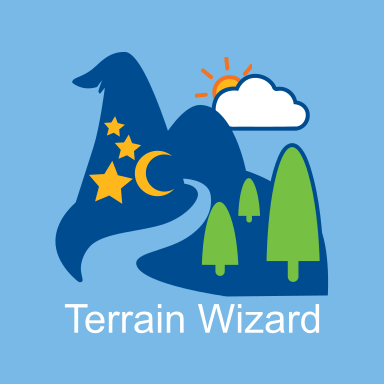Your cart is currently empty!
5 Powerful Keys To Vibrant RPG World-Building

Engaging and immersive role-playing games live in a vibrant game world. RPG world-building may seem daunting, but it can be broken down into key elements.
Everyone enjoys an immersive and vibrant gaming experience. You can create a game world that is rich and detailed. One seamlessly integrated with the gameplay and story.
In this guide, we’ll cover five keys to RPG world-building, from defining the essential elements of your world to adding depth and complexity to your setting.
Contents
Key 1 – Define The World

The first key in RPG world-building is to define the world where the game takes place. This involves creating a detailed setting that includes the world’s geography, history, culture, and inhabitants.
Here are some practical tips for defining your game world:
Start With The Basics
Begin by defining the physical features of your world, such as the terrain, climate, and natural resources. Consider the size and shape of your world and any unique features that may impact the game, such as magical or technological elements.
Develop The History
A rich and detailed history adds depth and complexity to your game world. Consider the significant events that have shaped the world, including wars, natural disasters, and cultural changes. Consider emerging political systems, power structures, and group conflicts or alliances.
Create The Culture
The culture of your game world is an essential component of RPG world-building. Consider the art, music, and literature that exist in the world and any unique traditions or practices. Think about the customs, beliefs, and values of the different groups.
Populate The World
The inhabitants of your game world can be human, humanoid, or entirely fantastical. Think about the creatures and monsters that live in the world and any supernatural or magical entities. Consider the different races and species that exist in the world, their physical characteristics, and cultural norms.
Consider The Economy
The economy of your game world can impact the gameplay in significant ways. Think about the various industries and occupations in the world. Also, consider the distribution of wealth and resources. Consider the impact of trade and commerce on different groups in the world.
Key 2 – Create the Environment

Once you have a general idea of the world you want to create, it’s time to start building the environment. This involves creating a detailed game world map and populating it with towns, cities, and other landmarks.
Here are some practical tips for creating a rich and immersive environment for your RPG:
Start With The Big Picture
Begin by creating a basic map of the world. This can be done using pencil and paper or with a digital tool such as Photoshop or GIMP. Once you have a rough sketch of the world, you can start filling in the details.
Consider The Geography
Think about the natural features of your game world, such as mountains, rivers, forests, and deserts. These will impact the types of creatures that inhabit the world and the challenges the players will face.
Populate The World
Create towns, cities, and other settlements throughout the game world. Think about the different races and cultures that exist in the world and how they might interact with one another. You can also add dungeons, ruins, and other landmarks to the world to make it more exciting and varied.
Create Backstories
Give each location in the game world a backstory. This will help players understand the history of the world and why certain things exist in certain places. Backstories can also provide hooks for quests and adventures.
Add Details
Once you have a basic map and locations, add details to the world. Think about the regional flora, fauna, weather patterns, and other environmental factors. This will help make the world feel more alive and dynamic.
Test The Environment
Before launching your game, playtest the environment to ensure it is balanced and fun. Get feedback from players and make adjustments as needed.
Key 3 – Develop the Story

The story drives your RPG. It gives your players a sense of purpose and direction. Also, it keeps them engaged and motivated to explore your world.
Here are some tips for developing a compelling story for your RPG:
Identify The Central Conflict
The first step in developing a story is identifying the central conflict driving the action. This could be a classic good vs. evil struggle or a more nuanced conflict between factions or individuals. Consider what kind of conflict will be most engaging for your players, and build your story around that.
Create A Cast Of Characters
No story is complete without a cast of characters to bring it to life. Think about the key players, including the hero or heroes, the villain or villains, and any supporting characters. Each character should have a unique personality and backstory to make them memorable and exciting.
Define The Story Arc
The story arc is the overall structure of your story. Usually, there are three stages, the beginning, middle, and end. Think about the key events that take place in the story. Make sure they build towards a climactic conclusion. Consider including plot twists or unexpected developments to keep your players on their toes.
Add Side Quests And Subplots
While the main story is the backbone of your RPG, it’s vital to include side quests and subplots to keep things interesting. These could be optional quests that players can choose to pursue. Also, they could be smaller stories that tie into the main plot. Whatever you choose, make sure that each side quest or subplot is engaging and rewarding in its own right.
Consider Player Choice
One of the hallmarks of RPGs is player choice. So it’s essential to design your story with this in mind. Think about how your players can shape the story through their decisions and actions. This could include branching story paths, multiple endings, or the ability to change the story’s outcome completely.
An Example Fantasy RPG Story
Let’s consider the story of a hypothetical fantasy RPG to show how these tips can be applied in practice.
In this game, the central conflict is between a powerful sorcerer who seeks to enslave the kingdom and a band of heroes who must stop him. The cast includes the sorcerer, the heroes, and various supporting characters such as the king and queen, a wise old sage, and a rogue thief.
The story arc follows the heroes as they gather allies, uncover clues about the sorcerer’s plans, and ultimately confront him in a climactic battle. Along the way, they encounter side quests and subplots, such as rescuing a kidnapped princess and uncovering a conspiracy among the nobility.
These quests and subplots somehow tie into the main plot, providing valuable information or opportunities to gain resources and allies.
The players’ decisions and actions can lead to multiple possible endings. For example, they might ally with one faction over another or discover a weakness in the sorcerer’s plan that allows them to defeat him more easily.
Key 4 – Add Details

This is where the real fun of RPG world-building begins. You get to start thinking about all the little elements that make your world unique and exciting.
Here are some tips to help you add depth and detail to your world:
Consider The Geography
The physical layout of your world can have a significant impact on its culture and history. Think about your world’s terrain, climate, and natural resources and how these factors might have shaped the societies that inhabit it.
Create A History
Every world has a backstory, and it’s up to you to create one for your game world. Consider the significant events and conflicts that have shaped your world’s past and how they might influence the present. This can also include the creation of myths and legends that are a part of the cultural identity of the world’s inhabitants.
Develop The Societies
The societies in your world will be a vital component of the player’s experience. Think about your world’s various cultures and factions and how they interact. Consider their social structure, economy, religion, and other key elements that shape their way of life.
Populate The World
The characters and creatures that inhabit your world can be just as important as the physical environment. Think about your world’s different races and species and the characters the players will encounter. Develop their personalities, motivations, and relationships to create a more dynamic world.
Think About The Little Details
Finally, remember the little things that can make your world more immersive and authentic. Consider things like clothing styles, architecture, and local cuisine, as well as the language and slang that the characters use. Just recognize that too much detail can be overwhelming.
Key 5 – Integrate the environment, game mechanics, and story

Now that you’ve created a detailed game world, it’s time to integrate the environment, game mechanics, and story in a natural and immersive way for the players.
Here are some tips to help you do that:
Consider The Setting
The environment you’ve created should play a role in the gameplay and story. Consider how your world’s geography, climate, and culture can affect the characters and the narrative. For example, a swampy area might slow movement and be home to dangerous creatures. At the same time, a desert could be full of ancient ruins and hidden treasures.
Build The Gameplay Mechanics Around The World
The gameplay mechanics should be influenced by the world you’ve created, not the other way around. Ensure the game’s rules are consistent with the world’s physical laws, cultural norms, and technological capabilities. For example, suppose your world has a low level of technology. In that case, firearms might be rare or non-existent, and melee combat might be more common.
Create Meaningful Choices
The players’ decisions should matter and have consequences in the game world. Give them choices that affect the story, the characters, and the environment, and ensure those choices align with the world you’ve built. For example, suppose your world is a dystopia where the ruling class controls everything. In that case, the players might choose between rebellion and conformity.
Use Storytelling Techniques To Enhance Immersion
Use techniques such as foreshadowing, dramatic tension, and character development to make the story more engaging and immersive. For example, you might have an NPC who foreshadows a significant event or a side quest that reveals more about the history of the world.
Make The Environment Interactive
The game world should be more than just a backdrop for the story. Give the players opportunities to interact with the environment in meaningful ways. For example, they might be able to use the environment to their advantage in combat, or they might have to solve puzzles that involve manipulating the environment.
Next Steps

Now that you have a solid understanding of world-building in role-playing games, it’s time to put your knowledge into action.
Here are some next steps to help you continue on your journey:
Start Small
Start with a small village or town. Creating an entire world as your first project can be overwhelming.
Collaborate With Others
Role-playing games are all about collaboration and teamwork. Find a group of like-minded individuals and work together to create a fantastic world.
Research And Gather Inspiration
The world is full of amazing stories, myths, and legends. Use them as inspiration for your world-building.
Practice, Practice, Practice
The more you work on your RPG world-building skills, the better you’ll become. Don’t be afraid to experiment and try new things.
Remember, RPG world-building is about having fun and creating something you and others can enjoy. You can make unique worlds that captivate and inspire others with practice and perseverance. Whether with your gaming group or the wider world, sharing your RPG world-building creations can be a great way to get feedback and improve your skills.
Explore Farther
Glue Stick Terrain is a great place to learn more.
